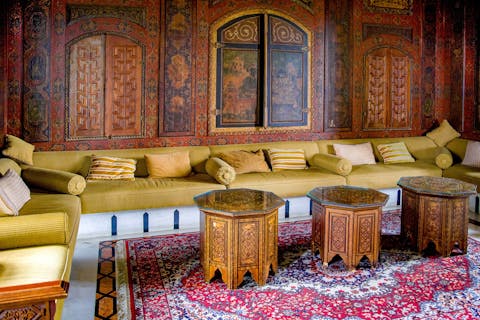Learn About Carpets & Textiles
Carpets and textiles not only serve a functional purpose, but can be beautiful and extremely valuable works of art.
Antique oriental carpet
The production of hand woven textiles has been a tradition that dates back to ancient times across cultures. These items have been highly sought after by collectors for centuries, with King Henry VIII notably owning hundreds of Turkish rugs that can often be seen in some of his famous portraits. Today collectors and enthusiasts all around the globe appreciate and admire the intricately woven, often vibrant and entrancing patterns of fine carpets and textiles. Not only are they coveted for their durability and practicality, but as decadent examples of the highest of skill and craftsmanship that can lend elegance and exquisiteness to any home.
Carpet origins
While oriental rugs are among the most highly prized categories of textiles, carpets and rugs come from all over the world, with the tradition of weaving following mankind wherever they ventured and established residence. Weaving techniques were used for clothing, baskets, and other practical items as well as rugs and tapestries, using whatever materials were available at hand depending on geographic resources.
Weaving
Most valuable antique rugs are woven on a loom with strands made from cotton, wool, or silk, called warps and stretched between two wooden beams. Then wefts are passed in alternation between each adjacent warp. The weaver then incorporates rows of looped knots between wefts which are later clipped to create the pile. The more knots there are, the more elaborate the design will be, and thus the more valuable.

Types of Carpets
Textiles are often classified by the environment in which they were manufactured, whether in a professional royal court, in a nomadic tribe settlement, or in a village setting. The most notable examples of royal carpets were produced during the 16th and 17th centuries for the Islamic courts. Though few survive today, these textiles had the greatest influence on worldwide carpet and rug design.
Tribal carpets were most often made for local use within the family or group of the weaver rather than to be sold. Because of this they hold a distinct cultural value as their designs directly reflect the cultural and societal traditions of the group.
"...each textile is unique in its pattern and construction, bearing its own individual features."
Village carpets are particularly unique as well due to the fact that they were traditionally woven without an initial drawing as the women who created relied solely on their own memory and creativity for their design. Because of this each textile is unique in its pattern and construction, bearing its own individual features. These carpets and rugs were made on looms that were set up permanently in the home, and upon their completion taken to local markets where they would represent the village of origin.
Textiles were also at times produced in bigger towns, especially in the 19th century in which markets were expanded in order to meet Western demand. Cities like Tabriz, Kashan, and Heriz are particularly well known epicenters for carpet weaving and manufacturing. Hajji Mollah Hassan Mohtasham is among the most famous and highly regarded textile workshops, as they are characterized by their consistency and harmony in patterning, silk purple finish of the selvage, and the maker’s extremely high standard of wool.
Related: The Art of Collecting Persian Rugs and Carpets
Textiles that stand the test of time
As one looks into the design of an antique carpet or rug, the design often time seems to move and one is enraptured by a sense of history and universality. In addition to their intrinsic value as impressive works of art and insurmountable craftsmanship, they serve as fantastic testaments to the skill and talent of women of the past, as weaving was largely considered a component of traditional homemaking. It is no wonder that for so long countless people across the world have regarded textiles as luxurious indicators of luxury, wealth, and culture, and will likely continue to do so for generations to come.

